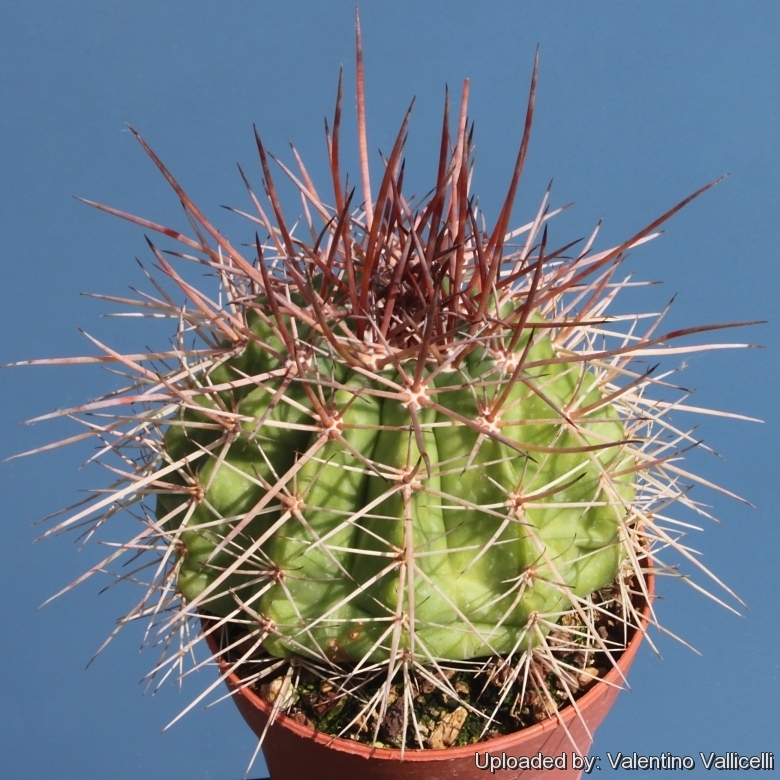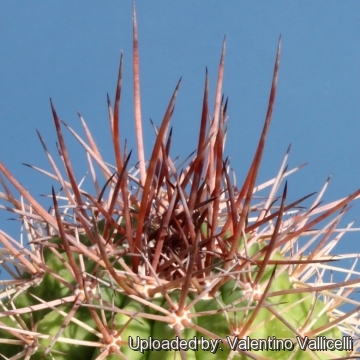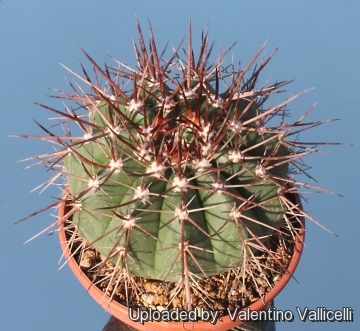Accepted Scientific Name: Melocactus oreas
Nova Acta Phys.-Med. Acad. Caes. Leop.-Carol. Nat. Cur. 18(Suppl. 1): 192. 1841

Melocactus sp. nova aff. oreas Photo by: Valentino Vallicelli
Origin and Habitat: Bahia, Brazil.
Synonyms:
See all synonyms of Melocactus oreas
back
Accepted name in llifle Database:Melocactus oreas Miq.Nova Acta Phys.-Med. Acad. Caes. Leop.-Carol. Nat. Cur. 18(Suppl. 1): 192. 1841Synonymy: 7
Accepted name in llifle Database:Melocactus oreas subs. cremnophilus (Buining & Bredero) P.J.BraunBradleya 6: 95. 1988Synonymy: 2
back
Description: Melocactus sp. nova aff. oreasSN|2280]]SN|17789]] is an unpublished catalogue name (nomen nudum), unusual among the Melocacti from that area in producing relatively stout dull-pink or brownish spines. It is thought to be a strong spined form of Melocactus oreasSN|17789]]SN|2280]].
Subspecies, varieties, forms and cultivars of plants belonging to the Melocactus oreas group
 Melocactus oreas Miq.: has stems that are globose to elongate and 10-35 cm tall. Distribution: below 500 m asl in eastern Bahia.
Melocactus oreas Miq.: has stems that are globose to elongate and 10-35 cm tall. Distribution: below 500 m asl in eastern Bahia.- Melocactus oreas subs. cremnophilus (Buining & Bredero) P.J.Braun: has smaller depressed globose stems, mostly less than 12 cm tall. Distribution: above 700 m asl in the more northern part of Bahia.
 Melocactus sp. nova aff. oreas: relatively stout dull-pink or brownish spines. It is thought to be a strong spined form of Melocactus oreas.
Melocactus sp. nova aff. oreas: relatively stout dull-pink or brownish spines. It is thought to be a strong spined form of Melocactus oreas.
Notes: The most remarkable part of a Melocactus is its cephalium a bristle-coated structure on the summit of the plant, only Melocactus, and the similar genus Discocactus possesses this type of permanent, apical, hatlike appendage. It’s only when a Melocactus reaches maturity that the cephalium begins to grow. Cylindrical, with a diameter distinctly smaller than that of the plant body below, the cephalium will keep growing for the rest of the plant’s life, but the body of the plant stops growing the moment the cephalium starts to form. As the plants age the cephalium doesn’t increase in circumference it will steadily grow taller.
 Melocactus sp. nova aff. oreas Photo by: Valentino Vallicelli
Melocactus sp. nova aff. oreas Photo by: Valentino Vallicelli Melocactus sp. nova aff. oreas Photo by: Valentino Vallicelli
Melocactus sp. nova aff. oreas Photo by: Valentino VallicelliCultivation and Propagation: Exclusively by Seeds. Sow in February-march in a light, sandy, porous soil. Cover germinating tray with glass to prevent seed from drying out. Germination is most successful at a temperature of 18 to 22° C.
Cultivation: These cacti are not the easiest things to grow and aren’t plants for beginners. This species grows from April to October, it can’t endure long stretches of total dryness, and also too much water will rot it, as its weak root systems tends to be inefficient at sucking up water from wet soil. Nonetheless, again as a result of their tropical origins, they need a fair amount of water, but allow the soil to dry quite a bit before watering again. Melocactus rests from October to April but can’t stand cold, or even fairly cool temperatures, so is indispensable to keep it above 8-12°C at all times, severe damage or death occurring at temperatures that the great majority of cacti wouldn’t mind in the least and prefer more frequent water in winter than other cacti, say once a month. Do not feed in winter.
The root system is weak and generally resents being repotted and can take a long time to re-establish. The soil mix should be very quick draining, prefers very bright light, not as much as the most arid growing cacti, but plenty nonetheless.













